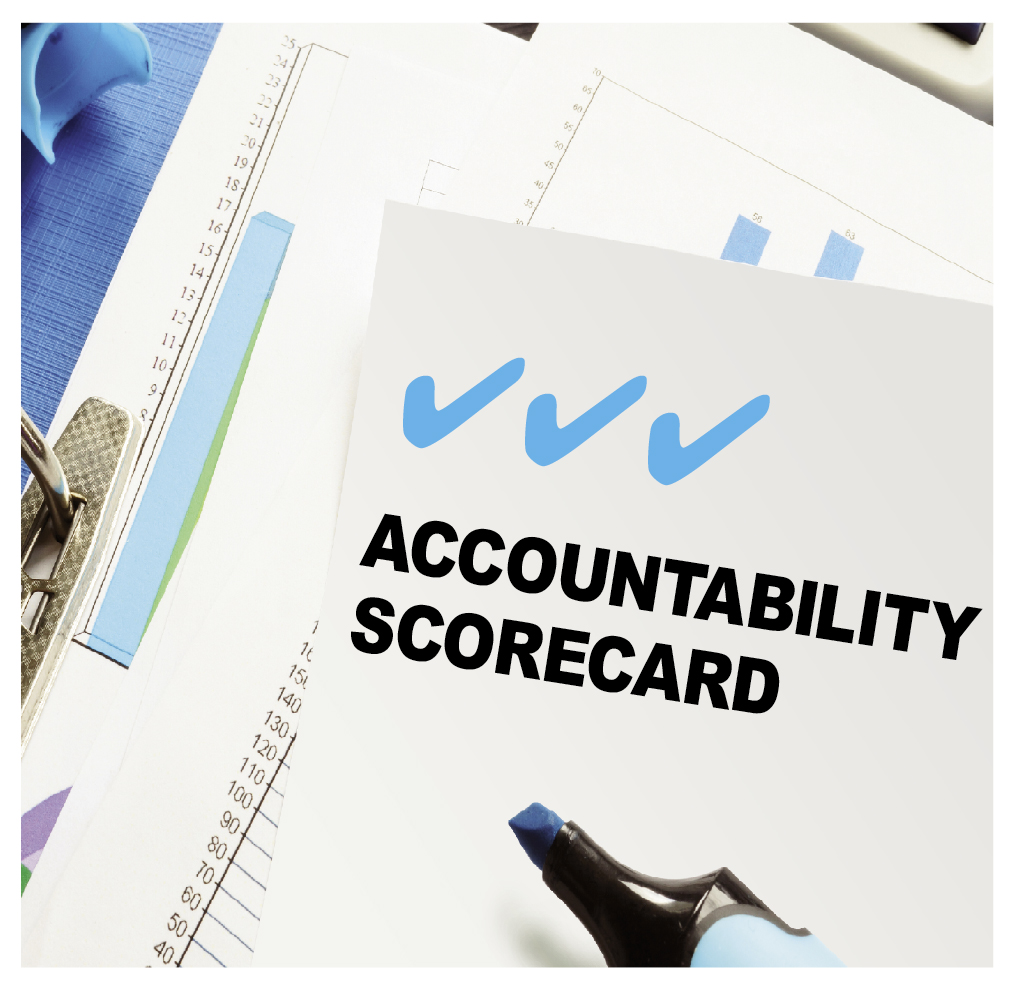Beyond Insurance
By F. Scott Addis, CPCU, CRA, CBWA, TRA
ACCOUNTABILITY SCORECARD
Tracking progress toward goal actualization
Cecil is a seasoned risk consultant with a reputable insurance agency. Founded in 1956, the firm employs 42 professionals including eight individuals whose focus is business development. Although the organization has a strong brand, differentiated value proposition, and an array of diagnostic tools and tactics, the agency’s organic growth has hovered at 4% over the past five years.
Frank, the agency principal, is getting increasingly frustrated as he has invested heavily in strategies to enhance internal efficiencies as well as the customer experience. In a staff meeting last week, Frank suggested that the organization would benefit from a heavy dose of accountability. Cecil responded, “One of the special attributes of this agency is that we are big boys and girls who do not need to be looked after. Each of us is responsible to ourselves. Accountability will slow us down.”
Trust in a team setting is the winning formula to increase commitment and morale, which leads to higher growth and profitability.
Let’s learn a bit more about Cecil. He is a 48-year-old family man who went to college on a swimming scholarship. Shortly after graduating, he married his high school sweetheart and now has three children. Cecil is an extrovert who loves to be the center of attention. While he is extremely bright, he is self-centered and lacks emotional intelligence. Of interest, the staff is getting increasingly frustrated with him as he refuses to be accountable for his actions. He comes and goes as he wishes and often uses the expression, “I report to the person who really counts—me.” While he does have a book of business hovering at $1,000,000 in revenue, it has been on the decline over the past few years. (You may be interested to know that the seven other producers also have taken on Cecil’s mindset.)
After hearing Cecil’s comment about accountability in the previous week’s meeting, Frank decided that it was time to research the benefits of instituting a culture of accountability, including an accountability scorecard.
Lack of accountability
Frank’s research uncovered that most sales professionals suffer from a lack of accountability. And, those who resist being accountable complain about being micro-managed and show frustration when asked to keep commitments. Yet these are the people who need to be held accountable. Most sales leaders compound the problem as they fear being thought of as “micro-managers.” For this reason, they tolerate missed deadlines, lack of punctuality, and subpar goal actualization.
Holding people accountable does not make the sales leader a micro-manager. Just the opposite. A good coach, mentor, and leader uses accountability supported by metrics to motivate and reinforce positive behaviors.
So, what is accountability and why is it so important in the workplace? Accountability is about ownership and initiative. It means that all colleagues are responsible for their actions, behaviors, decisions, and performance. It is the recognition that other team members are dependent on the results of your work product. When you and your team members consistently demonstrate ownership and accountability, trust is formed. Trust in a team setting is the winning formula to increase commitment and morale, which leads to higher growth and profitability.
Accountability is part of life. In fact, accountability plays a part in everything we do from paying our bills to raising our families. Accountability is one of the most important elements for achieving success and living a meaningful life. Whether in a business setting or in your personal life, accountability is one of your most precious assets. Henry J. Evans, the author of Winning with Accountability: The Secret Language of High-Performing Organizations, states, “When accountability is present, people keep their eye on a very clear prize. They know what they are working toward and how they are going to get there.”
Frank’s research gave him clarity about the fact that Cecil and his sales team viewed accountability in a negative light. They were living each day with trepidation of not living up to expectations. This did not need to be the case. If Frank approached it correctly, accountability would elevate work fulfillment, trust and the success of his entire team. Immediately, Frank went to work in the design of an accountability plan.
Accountability plan
Frank’s accountability plan was broken down into five steps as outlined below:
Step One—Accountability as a growth mindset. Frank’s first step was to create a different mindset around the assumptions, methods, beliefs, and attitudes held by Cecil and his sales team concerning accountability. For that reason, he painted a picture of a workplace culture that embraced “taking accountability,” not just “accepting responsibility.” It was his desire to demonstrate the impact on productivity and performance when the entire staff understood the power of ownership, involvement, and engagement.
Frank created the following slogan that he posted in the agency’s breakout room: “See It, Own It, Solve It, Do It. Take personal responsibility for making things happen. Respond to every situation with a can-do attitude, rather than explaining why it can’t be done. Be resourceful and accountable to yourself and your team.”
Step Two—Benefits of positive accountability. For his team to embrace accountability, Frank articulated the benefits of positive accountability on both individual and group levels. To accomplish this, he created a presentation on trust. Frank defined trust as, “Reliance on the integrity, strength and ability of another person. Confident expectation of something. To believe in another person.” He also introduced five accountability standards:
- Do the things we say we will do.
- Communicate openly and candidly.
- Ensure that our work is aligned with our scorecard.
- Creatively deal with obstacles.
- Constantly ask, “What else can I do?”
Step Three—SMART goals. Frank tied goal actualization to rewards. This involved working with Cecil and each member of his sales team to build both individual and group SMART goals.
“S” – Specific
“M” – Measurable
“A” – Attainable
“R” – Realistic
“T” – Time-bound
To Frank’s delight, each producer took pride in the goal-setting process as evidenced by the accomplishment of the following:
- The following questions were asked: “Which goal(s) will give me the most energy? Which goal(s) am I most committed to? What goal(s) offers the most value to me and the agency?”
- Execution strategy and achievement time frames. This involved one year, 90-day, monthly, and weekly planning.
- As Frank had used mental imagery in a prior life, he brought the concept to his team. The ability of Cecil and his colleagues to see themselves at the point of goal actualization was stimulating and empowering.
- It is here that Frank introduced the concept of a scorecard supported by rewards for goal achievement, as well as the consequences for not reaching agreed-upon objectives.
Step Four—Prospecting strategy map. Frank gave Cecil and the seven other risk consultants a template to design and build prospecting strategy maps, which included ideal client profiles, prospect pipeline management plans, and value proposition statements. Once completed, each person presented his or her map to Frank and other senior leaders of the agency. Through this process, Frank saw each person take ownership and pride in his or her plan for prospecting success.
Step Five—Accountability scorecard. Frank’s research evidenced that every great sales organization embraces a culture of accountability which includes measuring and monitoring results. For that reason, Frank envisioned a visible scorecard much like you would see in a sports stadium so his team would be able to see the results of their efforts 24/7.
Rather than paper or a messy chart on a whiteboard, he desired an interactive scorecard that showed key performance indicators. He also envisioned a leader board that tracked activity and outcomes for Cecil and his seven other producers. He had a hunch that healthy competition would spur commitment.
Before the scorecard could be built, Frank started with the end game in mind and worked backward. He set ambitious organic-growth and annual-revenue goals and broke down these figures into quarterly, monthly and weekly objectives. He then met with Cecil and the business development team, as well as others within the agency, to agree on exactly what people believed they should be accountable for.
This empowering exercise evidenced that the agency as a whole desired a scorecard to measure organic growth, customer engagement, cross-selling, retention, staff development, goal setting, prospect pipelines, referrals, quality at bats, and new business hit ratios. The staff also desired quarterly sessions to study and openly discuss activity and results.
To Frank’s surprise, Cecil and his business development team suggested weekly reporting sessions where each person shared the prior week’s performance as well as the game plan for the next week. It was obvious that Frank’s accountability plan was working. Cecil and his competitive team were winners.They relished the concept of the scorecard.
Although more has to be accomplished, Frank is already seeing significant returns from his agency’s culture of accountability and the scorecard. In a recent meeting, Cecil stated, “I feel like I am back in college participating in a swimming event. It was always my goal to beat my previous time, as well as those whom I competed against. I now have the same motivation. Our culture of accountability supported by the scoreboard drives me and my team. I can’t wait to get to work every day.” n
The author
Scott Addis is CEO of Beyond Insurance and an industry leader. His agency was recognized by Rough Notes magazine as a Marketing Agency of the Month, he was a Philadelphia finalist for Inc. magazine’s “Entrepreneur of the Year” award, and was selected as one of the “25 Most Innovative Agents in America.”
Beyond Insurance is a consulting firm that offers leadership training, cultural transformation, and talent and tactical development for enlightened professionals who are looking to take their organization to the next level. Since 2007, the proven and repeatable processes of Beyond Insurance have transformed agencies as measured by enhanced organic growth, productivity, profitability, and value in the marketplace.
To learn more about Beyond Insurance, contact Scott at saddis@beyondinsurance.com.






